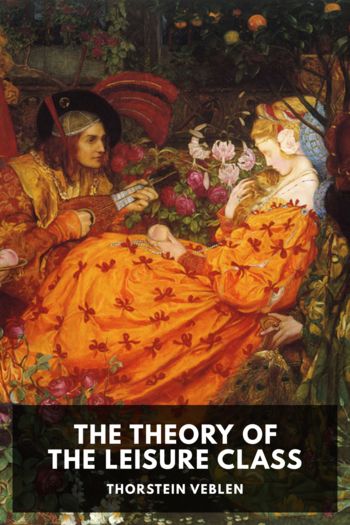The Theory of the Leisure Class by Thorstein Veblen (phonics readers TXT) 📕

- Author: Thorstein Veblen
Book online «The Theory of the Leisure Class by Thorstein Veblen (phonics readers TXT) 📕». Author Thorstein Veblen
Apart from this general control exercised by the norm of conspicuous waste over the ideal of feminine beauty, there are one or two details which merit specific mention as showing how it may exercise an extreme constraint in detail over men’s sense of beauty in women. It has already been noticed that at the stages of economic evolution at which conspicuous leisure is much regarded as a means of good repute, the ideal requires delicate and diminutive hands and feet and a slender waist. These features, together with the other, related faults of structure that commonly go with them, go to show that the person so affected is incapable of useful effort and must therefore be supported in idleness by her owner. She is useless and expensive, and she is consequently valuable as evidence of pecuniary strength. It results that at this cultural stage women take thought to alter their persons, so as to conform more nearly to the requirements of the instructed taste of the time; and under the guidance of the canon of pecuniary decency, the men find the resulting artificially induced pathological features attractive. So, for instance, the constricted waist which has had so wide and persistent a vogue in the communities of the Western culture, and so also the deformed foot of the Chinese. Both of these are mutilations of unquestioned repulsiveness to the untrained sense. It requires habituation to become reconciled to them. Yet there is no room to question their attractiveness to men into whose scheme of life they fit as honorific items sanctioned by the requirements of pecuniary reputability. They are items of pecuniary and cultural beauty which have come to do duty as elements of the ideal of womanliness.
The connection here indicated between the aesthetic value and the invidious pecuniary value of things is of course not present in the consciousness of the valuer. So far as a person, in forming a judgment of taste, takes thought and reflects that the object of beauty under consideration is wasteful and reputable, and therefore may legitimately be accounted beautiful; so far the judgment is not a bona fide judgment of taste and does not come up for consideration in this connection. The connection which is here insisted on between the reputability and the apprehended beauty of objects lies through the effect which the fact of reputability has upon the valuer’s habits of thought. He is in the habit of forming judgments of value of various kinds-economic, moral, aesthetic, or reputable concerning the objects with which he has to do, and his attitude of commendation towards a given object on any other ground will affect the degree of his appreciation of the object when he comes to value it for the aesthetic purpose. This is more particularly true as regards valuation on grounds so closely related to the aesthetic ground as that of reputability. The valuation for the aesthetic purpose and for the purpose of repute are not held apart as distinctly as might be. Confusion is especially apt to arise between these two kinds of valuation, because the value of objects for repute is not habitually distinguished in speech by the use of a special descriptive term. The result is that the terms in familiar use to designate categories or elements of beauty are applied to cover this unnamed element of pecuniary merit, and the corresponding confusion of ideas follows by easy consequence. The demands of reputability in this way coalesce in the popular apprehension with the demands of the sense of beauty, and beauty which is not accompanied by the accredited marks of good repute is not accepted. But the requirements of pecuniary reputability and those of beauty in the naive sense do not in any appreciable degree coincide. The elimination from our surroundings of the pecuniarily unfit, therefore, results in a more or less thorough elimination of that considerable range of elements of beauty which do not happen to conform to the pecuniary requirement. The underlying norms of taste are of very ancient growth, probably far antedating the advent of the pecuniary institutions that are here under discussion. Consequently, by force of the past selective adaptation of men’s habits of thought, it happens that the requirements of beauty, simply, are for the most part best satisfied by inexpensive contrivances and structures which in a straightforward manner suggest both the office which they are to perform and the method of serving their end. It may be in place to recall the modern psychological position. Beauty of form seems to be a question of facility





Comments (0)